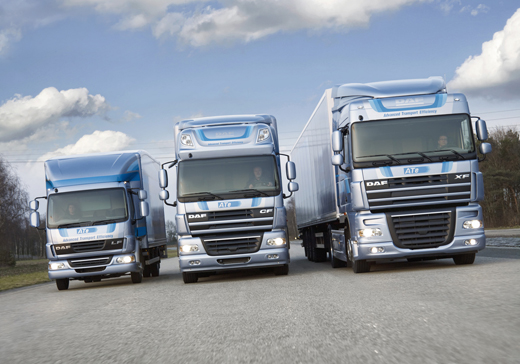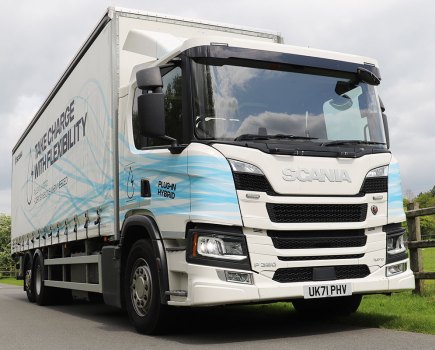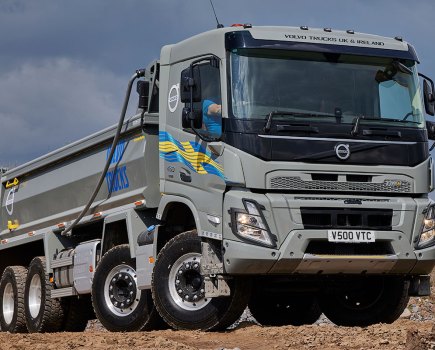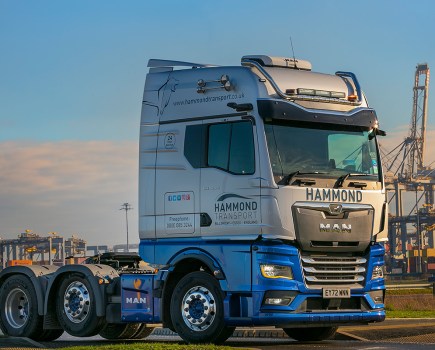
Fetching a DAF built for frugality from its homeland illustrated just how hard the Dutch manufacturer is working to help keep its customers in business
By Steev Hayes • Photography Steev Hayes/DAF
Dutch truck maker DAF hasn’t exactly been at the forefront when it comes to using the latest technology – fuel saving or otherwise – but it has rather held back, working to the notion that ‘if it ain’t broke, don’t fix it’. The 95-series took DAF into another league, but when it came to launching the 95XF, where other manufacturers were adopting electronic control units (ECUs), disc brakes and other gizmos, DAF stuck to drums and more mechanical means. As long as it was meeting the legal requirements necessary as far as emissions etc were concerned, it could see no good reason to change.
This actually worked in DAF’s favour at the time, as operators hauling goods to more inhospitable places preferred to run trucks they or their drivers could fix if they had a problem when they were far away from the safety net offered by dealer networks dotted across the civilised areas of Europe. Those hauling equipment and supplies to the gold mines and oilfields in remote locations in Russia and Kazakhstan for example needed to be able to get their trucks going, or nurse them on to somewhere where they could get help to fix any problems. Owner-operator Alan Kendall used a 1996 N-plate 95-series DAF with the spacious Super Space Cab hauling goods and equipment to gold mines and oil fields across Asia (Trucking International, September 1998). Bought for its simplicity and strength of build – Alan said at the time someone could ‘take the truck apart and leave it in a pile of bits, and he could put it together again’ to illustrate how well he knew the truck and how easy it was to fix – the DAF was winterised to cope with the extreme conditions he operated under. It was also fitted with satellite communication systems and a 600-litre diesel tank.

All that said, DAF being a step or two behind the competition hasn’t hindered its overall success. In fact it could be said the Paccar-owned manufacturer has been rather canny, with the Dutch marque having been in the top seller list in the UK for several years now. This year also sees the XF105 become best-seller in Europe too.
But key to operating trucks now is cost cutting, and nowhere is that more important than getting the best fuel economy. Of course, a balance must be struck between getting the best mpg from the truck and getting the job done and the load delivered.
In July, DAF despatched a nominal 40-tonner European ‘standard’ heavy truck for appraisal in the UK. A left-hooker, it is the Dutch truck manufacturer’s sterling effort at giving operators and drivers the choice of a luxury truck with all the gear and add-ons that’ll offer both efficiency and the best mpg.
Dubbed DAF ATe (Advanced Transport efficiency), the basic platform is a DAF XF105 chassis with 460 bhp Paccar MX motor mated to a 12-speed AS-Tronic automated transmission. The engine is to EEV (Enhanced Environmentally-friendly Vehicle) standards – reducing soot particle emissions by 33 per cent over Euro 5 engines – with new pistons, rings and liners that reduce internal friction and increase engine efficiency. It has a fully encapsulated exhaust manifold (and turbocharger, which increases efficiency through improved air management) with optimised fuel injection and transmission software that ensure the best revs and gearing for any given situation. The transmission software has a shifting strategy optimised for lowering fuel consumption.
The driver is able to shift manually at speeds below 30 kmh and when using the MX engine brake, but the software makes the gear choices at all other times. There is an engine idle shutdown facility that operates after five minutes to save valuable fuel with the vehicle at rest, and the speed limiter is set to 85 kmh (52.82 mph) for optimum on-road fuel efficiency. Accommodation/workplace is the roomy Space Cab with single bunk. The cab has been given some fuel reduction and aerodynamics attention. It has an air kit (with adjustable roof spoiler for different height trailers – a new one with greater adjustment range due out later this year will be approximately 25 kg lighter than the current version), side skirts, new three-piece mudguards designed to be less susceptible to damage when driving on and off loading docks and ferries, improved mud flaps, and tyres with low rolling resistance.
Tyres fitted are Goodyear 315/70R22.5 which has the effect of lowering overall height of the truck, further reducing wind resistance. The truck is also fitted with an MX engine brake and adaptive cruise control (ACC) with Forward Collision Warning (FCW).
Weight is also a factor in fuel consumption ratings. The heavier the combination of truck (and trailer) and load, the more fuel you use to shift it. Consequently, operators want the lightest trucks to enable them to shift the most payload. So DAF uses ally fuel and air tanks on the ATe chassis to shave off unnecessary kerb weight and to add to overall payload capacity.
Incidentally the Ate concept is available across DAF’s XF, CF and LF ranges.
On the road – We drove the truck on a one-way trip from the DAF factory at Eindhoven in the Netherlands to its UK headquarters at Thame in Oxfordshire – a total mileage of some 343 miles (552 km).
Setting off, the roads to the motorway were quite busy, with a spattering of traffic lights to slow things down. So the initial part of the journey was slow and fairly painful as far as progress and fuel consumption were concerned.
But once we were free of the town, things livened up and we were able to engage the cruise control, over-run was set at a couple of clicks over 85 kmh, and we calculated and set the distance we wanted between us and vehicles in front on the ACC to keep us safe. Should we gain on traffic ahead, the FCW won’t actually stop the vehicle should the truck be approaching stationary traffic for example, although the MX engine brake will slow the truck – sharply if it deems it necessary – but apparently audible warnings will make the driver acutely aware of the developing situation, at which point he’ll need to intervene with the footbrake. We didn’t experience this scenario, but we are sure the system is as effective as claimed.
The driver must also keep himself aware of the traffic situation around him, because should he gain on a slower vehicle on a motorway or dual-carriageway, unless he pulls out and overtakes, the adaptive cruise control will slow the truck to the leading vehicle’s speed, which could cost him time. You soon get used to judging when you are gaining on slower vehicles and when to take to the overtaking lane without blocking other faster traffic for too long.
The driver is kept aware of fuel usage via a driver information panel, where he can keep an eye on how he’s performing. I found once I was familiar with it, I was almost competing with myself to try and improve on consumption figures. The screen showed an average of around 10 mpg en route, as the truck was fully freighted, weighing in just shy of 40 tonnes to allow for the combined weight of a driver and passenger.
A helpful person at the Eindhoven headquarters had kindly dialled the route into the satellite navigation system we had on board, which was accurate enough up to a point (but it tried directing us off the motorway a few kilometres before the turning to the Channel Tunnel and Le Shuttle).
We picked up the N2, then onto the A67/E34 heading to Antwerp/Eersel and into Belgium. The E34 took us to the Antwerp ring road, where we joined the E17, turning the truck towards Brugge and Gent, eventually hitting the E40 towards Oostende and into France, and heading for Le Shuttle at Calais for the crossing to Folkestone.
A short break followed, before we left the holding area through the notoriously tight exits and drove onto the train to trundle under the English Channel. Regular users of the Channel Tunnel shuttle trains will know of the need to centre the truck in line with the steel-framed rolling stock trailers and their running ramps when boarding. This necessitates almost passing through the trailer and out the other side, before undertaking some tight turning to line the rig up, and the DAF’s manoeuvrability really proved its worth here. Around an hour later, it was time to fire up the DAF and we hit the Friday night traffic for the 130-odd mile run to Thame.
Of course, The Netherlands doesn’t offer much in terms of testing terrain. It’s very flat, and the only real hills are the slip roads onto the motorways. In fact, the route all the way back to Thame was fairly free of any real challenges. The worst part was unsurprisingly on the M25 from around Junction 11 to Junction 16 at the M25/M40 interchange. Once on the slip road things eased off and we were back up to speed. We left the M40 and joined the A329 towards Thame to try the handling on a tight and twisty country road – and the truck didn’t disappoint.

Verdict – DAF has pulled out all stops to get the right combination in this vehicle to enhance operator profitability while giving drivers a great workplace.
The 460 bhp MX motor packs enough punch to run comfortably at 40-44 tonnes GVW, allowing the truck to make good progress, the truck is geared and the 12-speed AS-Tronic transmission is programmed for optimum fuel efficiency, the roof spoiler now has a winding handle the driver can use to adjust its height easily to match it to different trailers, while the Space Cab offers drivers enough luxury and space to have multiple nights away, but is lower than the Super Space Cab, so will offer less wind resistance.
Of course, some devices fitted here are optional extras, but this drive in the DAF proved what can be achieved with a fully-laden truck over a route at a speed set below the maximum permitted road limit and using the driver aids available now, including ACC etc. It’s a very relaxed way of driving, and providing the driver hasn’t got the boss or a customer pressuring him to be somewhere he can’t be given the time, it should lead to a less stressful life for him, better fuel consumption for the operator, and less wear and tear on the truck.
And at £88,900 for the basic spec truck, we reckon it’s an all-round winner.






